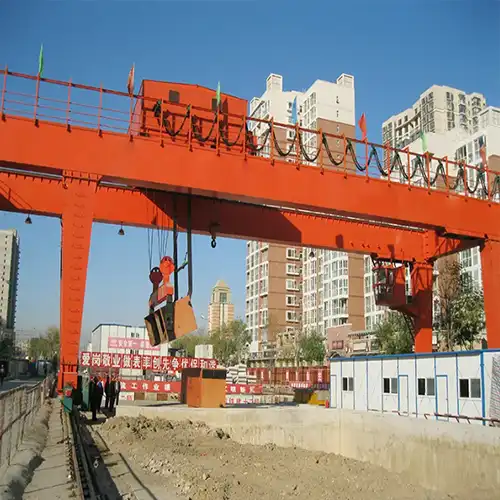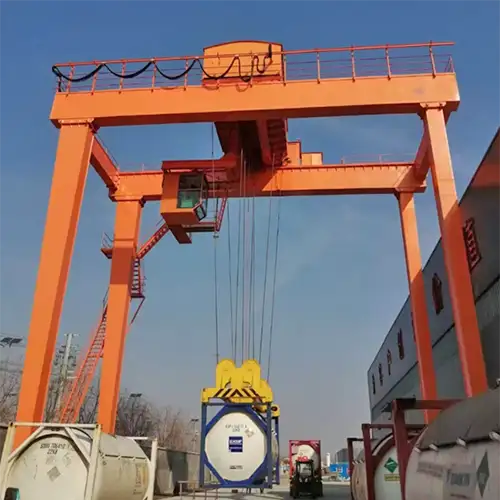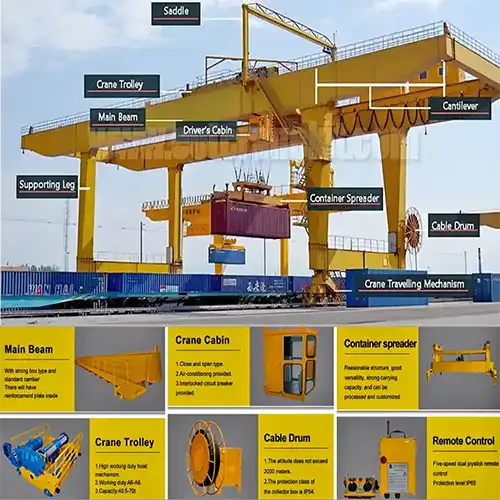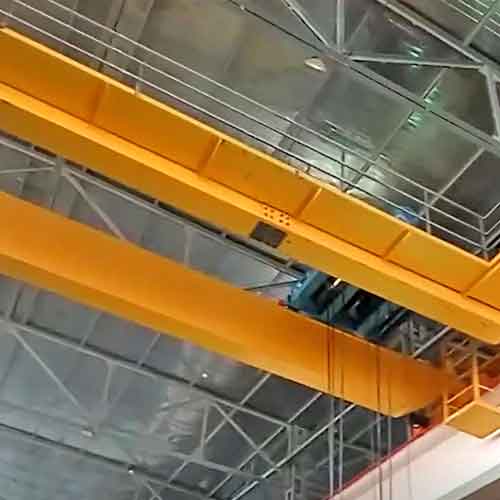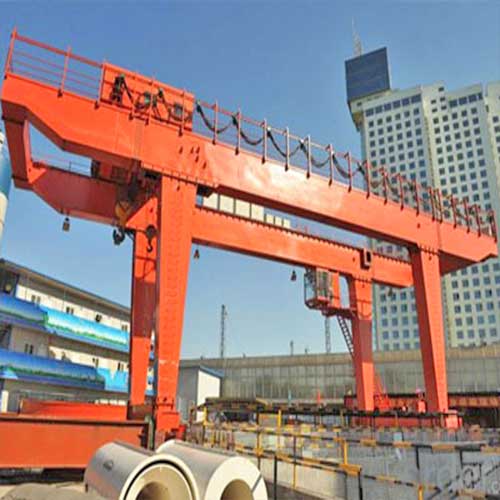45/16 Ton Gantry Cranes for Subway & Tunnel Construction Soil Handling
Designed for spoil soil handling, custom gantry cranes deliver precise lifting & reliable performance in demanding subway & tunnel construction projects.
Category: Construction
Your Trusted Gantry Crane Manufacturer & Supplier
45/16 Ton Gantry Cranes for Subway Tunnel Construction
Rail Mounted Gantry Crane with Customized Spreader for Spoil Soil Handling
Designed for spoil soil handling, these cranes deliver precise lifting and reliable performance in demanding subway and tunnel construction projects.
45 /16 Ton Spoil handling Gantry Cranes for Subway and Tunnel Construction
Discover robust gantry cranes designed to streamline spoil soil handling, ensuring smooth and efficient subway and tunnel construction, 45 ton, 50 ton or customized.
In subway and tunnel construction, managing and disposing of Spoil—the residual material left over from excavation—is a critical task. Gantry cranes designed specifically for spoil soil handling play a vital role in these projects. These cranes are essential for efficiently lifting and transporting Spoil from deep underground locations to the surface, where it can be removed or processed further.
Spoil handling gantry cranes are engineered to operate in the challenging environments typical of tunnel construction sites. They are robust and reliable, capable of handling heavy loads and operating under demanding conditions. The cranes' design ensures they can navigate tight spaces and maneuver within the confines of tunnel structures, making them indispensable for maintaining project schedules and safety standards.

rail mounted gantry crane for soil handling

Customized spreader for spoil soil hanlding at construction site of tunnel or subway
Role of spoil soil handling in Construction Efficiency
Effective spoil soil handling directly impacts the overall efficiency of subway and tunnel construction projects. Proper management of Spoil is crucial for several reasons:
- Timely Removal: Efficient Spoil removal prevents accumulation, which could otherwise delay construction progress. By ensuring that Spoil is promptly and safely transported out of the tunnel, gantry cranes help keep projects on schedule.
- Site Cleanliness: Proper spoil soil handling reduces site clutter and improves safety conditions for construction workers. A clean and organized work environment minimizes the risk of accidents and facilitates smoother operations.
- Resource Optimization: By streamlining the process of spoil soil handling, resources such as labor and machinery can be used more effectively. Gantry cranes optimize the workflow by automating and simplifying the handling of heavy materials, reducing the need for manual labor.
- Environmental Compliance: Efficient spoil soil handling supports environmental management efforts by ensuring that waste is managed properly and disposed of according to regulations. This helps in minimizing the environmental impact of construction activities.
In summary, spoil soil handling gantry cranes are essential for ensuring the smooth operation of subway and tunnel construction projects. They enhance operational efficiency, support safety measures, and contribute to timely project completion.
Types of Spoil Handling Gantry Cranes
Standard Gantry Cranes
Standard gantry cranes are commonly used in various industrial applications, including construction. These cranes feature a basic gantry design with a rigid framework that supports a trolley system, allowing for the lifting and moving of materials. In the context of spoil soil handling in subway and tunnel projects, standard gantry cranes can efficiently handle the weight of Spoil and perform general lifting tasks.
Key Characteristics:
- Fixed Span: Typically, standard gantry cranes have a fixed span, which may limit their flexibility on different sites.
- Robust Construction: Designed to handle heavy loads and operate in demanding environments.
- Basic Operation: Equipped with fundamental lifting and trolley mechanisms suitable for straightforward spoil soil handling tasks.
Standard gantry cranes are suitable for projects where the site conditions and material handling requirements are relatively consistent.
Main Types of Spoil Handling Gantry Crane Designs with A-Frameand U-Frame Spoil
In metal and subway construction, the efficient handling of Spoil and other materials is critical to maintaining project timelines and safety standards. A-Frame and U-Frame spoil soil handling gantry cranes are two prominent designs that cater to these needs, each offering unique advantages suited to different construction environments.

Spoil Soil Handling A-Frame Gantry Crane
Design and Structure
The A-Frame spoil soil handling gantry crane features a traditional A-shaped frame that provides robust support and stability. This design is particularly effective for high-capacity lifting and stable operation under heavy loads.
- Frame Structure: The A-shaped frame is designed to distribute weight evenly, enhancing stability and reducing stress on individual components.
- Load Capacity: Typically designed to handle substantial loads, these cranes are well-suited for heavy-duty applications in both metal and subway construction.
- Height and Span: Customizable height and span options allow for versatility in various construction sites, from confined subway tunnels to expansive metal production facilities.
Applications
A-Frame gantry cranes are widely used in environments where heavy-duty lifting and precise handling are required. Their applications include:
- Subway Construction: Efficiently lifting and dumping Spoil from tunnel excavations, facilitating smooth construction progress.
- Metal Production: Handling large volumes of molten Spoil and other by-products, ensuring continuous and safe production operations.
Advantages
- Stability: The A-frame design offers exceptional stability, crucial for handling heavy loads without compromising safety.
- Durability: Built with high-strength materials, these cranes are designed to withstand harsh environments and heavy use.
- Versatility: Adjustable height and span options make these cranes adaptable to various site conditions and project requirements.

Spoil Soil Handling U-Frame Gantry Crane
Design and Structure
The U-Frame spoil soil handling gantry crane features a U-shaped frame, which provides a broader and more open working area. This design is particularly advantageous for projects requiring frequent movement and placement of large loads.
- Frame Structure: The U-shaped frame offers a wide base and a lower center of gravity, enhancing stability and operational efficiency.
- Load Capacity: Designed to handle substantial loads, similar to A-Frame cranes, but with added flexibility for complex lifting operations.
- Height and Span: Customizable configurations to suit specific project needs, including high lifts and extensive spans for larger construction sites.
Applications
U-Frame gantry cranes excel in environments where a wide working area and flexible handling are essential. Their applications include:
- Subway Construction: Facilitating the efficient movement and dumping of Spoil, especially in areas requiring extensive lateral movement.
- Metal Production: Handling large, heavy by-products and ensuring seamless operation within spacious production facilities.
Advantages
- Flexibility: The U-frame design allows for greater lateral movement and access to the working area, improving operational efficiency.
- Stability: Despite the open frame, the design ensures stability under heavy loads, critical for safety and reliability.
- Efficiency: Enhanced working area and movement flexibility lead to more efficient operations, reducing downtime and increasing productivity.
Key Features of Both Crane Types
Both A-Frame and U-Frame spoil soil handling gantry cranes share several essential features that make them suitable for demanding construction environments:
- Hydraulic Tipping Mechanism: Allows for efficient dumping of Spoil and other materials, minimizing manual handling and improving safety.
- Variable Frequency Drives (VFD): Ensures smooth and precise control of lifting and movement operations, enhancing overall efficiency.
- Safety Features: Equipped with track clamps, emergency stop systems, and other safety mechanisms to prevent accidents and ensure secure operations.
- Customization Options: Both crane types can be tailored to meet specific project needs, including adjustable spans, specialized attachments, and bespoke configurations.
Selecting the appropriate spoil soil handling gantry crane for your metal or subway construction project depends on specific operational needs and site conditions. A-Frame cranes offer robust stability and durability for heavy-duty tasks, while U-Frame cranes provide flexibility and efficiency in more complex environments. By understanding the unique advantages and applications of each crane type, project managers can make informed decisions that enhance productivity and ensure safe, efficient operations.
Specialized Spoil Handling Gantry Cranes
Specialized spoil soil handling gantry cranes are engineered specifically for the unique demands of handling Spoil in subway and tunnel construction. These cranes are designed with features tailored to the challenging conditions of underground and confined workspaces.
Key Features:
- Hydraulic Tipping Mechanism: Includes hydraulic systems for tipping and dumping Spoil efficiently, ensuring smooth material discharge.
- Enhanced Load Capacity: Built to handle heavier and bulkier Spoil materials, with reinforced structures to manage high-stress loads.
- Custom Attachments: Often equipped with specialized attachments like Spoil buckets or clamshell grabs to facilitate the handling of Spoil.
These cranes are ideal for projects that require advanced functionality and durability due to the complex nature of spoil soil handling.
Variable Span Gantry Cranes for Adaptive Construction Sites
Variable span gantry cranes offer flexibility in their span adjustments, making them suitable for construction sites where the width of the operational area may change. This adaptability is particularly beneficial in subway and tunnel construction, where the span requirements can vary depending on the site conditions and construction phases.
Key Features:
- Adjustable Span: Allows the crane to modify its span between specified ranges (e.g., 20 to 27 meters), accommodating different site configurations.
- Versatile Operation: Facilitates the handling of Spoil across various site layouts and widths, improving operational efficiency.
- Enhanced Mobility: Designed to adapt to changing construction site conditions, reducing the need for additional equipment or modifications.
Variable span gantry cranes are ideal for dynamic construction environments where adaptability and flexibility are crucial for maintaining project flow and efficiency.
Core Features of Spoil Handling Gantry Cranes
Capacity and Performance
Capacity and performance are critical factors in selecting a gantry crane for spoil soil handling. These aspects determine how effectively the crane can manage the heavy loads typically associated with Spoil removal in subway and tunnel construction.
- Main Hook Capacity: This is the maximum weight the main hook can lift. For spoil soil handling gantry cranes, the main hook capacity is typically high, ranging from 45 to 50 tons, to handle the substantial weight of Spoil efficiently.
- Auxiliary Hook Capacity: The auxiliary hook provides additional lifting capacity and can handle lighter loads or assist in specific tasks. Its capacity generally ranges from 10 to 20 tons, depending on the crane's design and requirements.
Lifting and Dumping Mechanisms
The efficiency of spoil soil handling also relies heavily on the crane's lifting and dumping mechanisms. These mechanisms are designed to ensure smooth and effective management of Spoil materials.
- Hydraulic Tipping Mechanism: This feature is essential for the efficient dumping of Spoil. The hydraulic tipping mechanism includes a hydraulic station and a tipping hook, allowing the crane to tilt and dump the Spoil bucket accurately. This mechanism ensures that Spoil is discharged quickly and efficiently, minimizing downtime and enhancing productivity.
- Lifting Height and Reach: The crane's lifting height refers to the maximum vertical distance it can lift materials, typically up to 40 meters. The reach encompasses the horizontal distance the crane can cover, which is crucial for positioning the crane effectively within the tunnel or construction site.
Drive and Control Systems
The drive and control systems of a gantry crane are crucial for its operation, affecting both performance and safety.
- Variable Frequency Drives: These drives control the speed of the crane's motors, allowing for smooth acceleration and deceleration. Variable frequency drives enhance operational efficiency by adjusting the crane's speed according to the load and operational needs, reducing wear and tear on mechanical components and improving energy efficiency.
- Operator Controls and Safety Features: The operator controls are typically housed in a dedicated cabin and include various levers, buttons, and displays for crane operation. Safety features often include emergency stop buttons, limit switches, and safety interlocks to prevent accidents and ensure safe operation. Advanced control systems may also offer remote operation capabilities and diagnostic tools to monitor crane performance and maintenance needs.
These core features collectively ensure that spoil soil handling gantry cranes operate efficiently, safely, and effectively in the demanding environment of subway and tunnel construction.
Design and Construction Components
Gantry Frame and Structural Integrity
The gantry frame is the backbone of the gantry crane, providing the structural support needed to handle heavy loads and withstand the harsh conditions of construction sites.
- Gantry Frame Design: The frame typically consists of two vertical supports (legs) and a horizontal beam (crossbeam) connecting them. The design ensures stability and strength, enabling the crane to bear significant loads without deforming or collapsing.
- Material Strength: Constructed from high-strength steel or other durable materials, the frame must resist stress and maintain structural integrity under load. Rigorous testing and quality assurance processes are employed to ensure the frame meets safety and performance standards.
- Durability: The gantry frame is designed to withstand the environmental challenges of construction sites, such as moisture, dust, and temperature fluctuations, which could impact its performance and lifespan.
Trolley and Running Mechanism
The trolley and running mechanism are crucial for the crane's mobility and operational efficiency.
- Trolley Design: The trolley moves along the gantry frame, carrying the lifting mechanism and load. It is equipped with wheels or rollers designed to handle heavy loads and operate smoothly along the gantry rails.
- Running Mechanism: Includes the system of wheels and drive components that allow the trolley to move horizontally across the gantry frame. This mechanism ensures precise positioning and smooth movement of the load.
- Drive System: Typically powered by electric motors, the drive system allows for variable speeds and direction control, enhancing the crane's versatility and efficiency in handling materials.
Hydraulic Systems and Mechanical Components
Hydraulic systems and mechanical components are essential for the crane's lifting and dumping operations.
Hydraulic Systems: These systems use hydraulic fluid to transmit power and operate lifting mechanisms. They include hydraulic cylinders, pumps, and valves that control the movement and dumping of Spoil.
- Hydraulic Cylinders: Provide the force needed to lift and lower loads. They must be robust and capable of handling high pressures.
- Hydraulic Pumps: Supply the fluid pressure required for the cylinders to function, ensuring reliable operation of the crane.
- Hydraulic Valves: Control the flow of hydraulic fluid and direct it to the appropriate cylinders for lifting or tipping operations.
- Mechanical Components: Include gears, bearings, and linkages that support the crane's movement and operation. These components must be precisely engineered to ensure smooth and reliable performance.
Safety and Operational Features
Safety and operational features are integrated into the crane's design to ensure safe and efficient operation.
Track Clamps: Track clamps are used to secure the crane to its rails when not in operation, preventing unwanted movement and ensuring stability. They are essential for maintaining the crane's position during loading and unloading.
Emergency Systems: Include various safety mechanisms designed to protect operators and equipment. These systems may feature:
- Emergency Stop Buttons: Allow for immediate shutdown of the crane in case of an emergency.
- Limit Switches: Prevent the crane from moving beyond its operational limits, avoiding potential damage or accidents.
- Safety Interlocks: Ensure that the crane operates only under safe conditions, preventing accidental activation or operation.
In summary, the design and construction components of spoil soil handling gantry cranes are carefully engineered to provide strength, reliability, and safety. From the structural integrity of the gantry frame to the precision of the hydraulic systems and the robustness of safety features, each component plays a vital role in ensuring the crane's effective performance in demanding construction environments.
Operational Best Practices
Pre-Operation Inspections
Before starting any spoil soil handling gantry crane, thorough pre-operation inspections are crucial to ensure the equipment is safe and ready for use.
- Visual Inspection: Check for any visible damage or wear on the gantry frame, trolley, and lifting mechanisms. Look for cracks, rust, or deformation that might indicate structural issues.
- Hydraulic System Check: Inspect hydraulic lines, cylinders, and fluid levels. Ensure there are no leaks and that the hydraulic system is functioning properly.
- Electrical System Review: Verify that all electrical connections, controls, and safety devices are in working order. Check for loose wires, damaged components, or malfunctioning controls.
- Load Testing: Conduct a test run with a load similar to what the crane will handle during operations. This ensures that the crane can lift and move the load safely and effectively.
Routine Maintenance and Safety Checks
Regular maintenance and safety checks are essential for prolonging the life of the crane and preventing accidents.
- Scheduled Maintenance: Follow the manufacturer's recommended maintenance schedule, which may include lubricating moving parts, tightening bolts and connections, and replacing worn components. Regular maintenance helps avoid unexpected breakdowns and ensures smooth operation.
- Safety Inspections: Periodically inspect safety features such as track clamps, limit switches, and emergency stop buttons. Ensure they are functioning correctly and can be activated quickly in case of an emergency.
- Hydraulic and Mechanical Checks: Regularly inspect hydraulic fluids, pumps, cylinders, and mechanical components for signs of wear or leaks. Replace any worn or damaged parts promptly to maintain operational efficiency.
Efficient Operation Techniques
Employing efficient operation techniques can enhance productivity and safety during crane operations.
- Proper Load Handling: Ensure that loads are evenly distributed and secured before lifting. Avoid overloading the crane beyond its rated capacity to prevent stress on the equipment and ensure safe operation.
- Smooth Movements: Operate the crane's controls smoothly to avoid sudden starts, stops, or jerky movements. Gradual acceleration and deceleration help prevent strain on the crane and ensure accurate load positioning.
- Operator Training: Ensure that crane operators are thoroughly trained and familiar with the crane's controls and safety features. Proper training minimizes the risk of accidents and enhances the efficiency of operations.
- Site Awareness: Maintain awareness of the surrounding construction site and any potential obstacles. Ensure that the crane's path is clear of obstructions and that the area is safe for operation.
By following these operational best practices, you can ensure the safe, efficient, and reliable use of spoil soil handling gantry cranes in subway and tunnel construction projects. Regular inspections, maintenance, and proper operation techniques contribute to the longevity of the equipment and the overall success of the construction efforts.
Selecting and Customizing Gantry Cranes
Key Considerations for Selection
When selecting a gantry crane for spoil soil handling in subway and tunnel construction, several key factors must be considered to ensure the crane meets the project's requirements.
- Load Capacity: Determine the maximum weight of the Spoil and other materials the crane will need to handle. Choose a crane with a load capacity that comfortably exceeds the maximum expected load to ensure safe and efficient operation. For spoil soil handling, this often means selecting a crane with a main hook capacity of 45 to 50 tons and an auxiliary hook capacity suitable for lighter loads.
- Span and Reach Requirements: Evaluate the width and length of the construction site to ensure the crane can effectively cover the necessary span and reach. The crane should be able to handle the Spoil within the constraints of the tunnel or construction area. Consider whether a fixed or variable span crane is more appropriate, depending on the site's layout and any potential changes in span requirements.
- Construction Site Conditions: Assess the specific conditions of the construction site, including space limitations, environmental factors, and potential obstacles. The crane must be able to operate effectively in the site's unique conditions, whether it's an underground tunnel with restricted space or an open area with varying ground conditions.
Customization Options
Customizing a gantry crane can enhance its functionality and efficiency for specific project needs.
Adjustable Span Features: If the construction site has varying widths or requires flexibility, consider a crane with adjustable span capabilities. This feature allows the crane to modify its span between specified ranges, such as 20 to 27 meters, accommodating changes in site layout or operational needs. Adjustable span features ensure the crane remains versatile and adaptable to different construction scenarios.
Specialized Attachments for Specific Tasks: Customizing the crane with specialized attachments can improve its effectiveness in handling specific tasks related to Spoil management. Options include:
- Spoil Buckets or Clamshell Grabs: Designed for efficiently collecting and dumping Spoil. These attachments can be tailored to handle the particular type and quantity of Spoil encountered in the project.
- Hydraulic Tipping Mechanisms: For cranes used in Spoil dumping, specialized hydraulic tipping mechanisms can be added to facilitate the smooth and controlled discharge of Spoil.
By carefully considering these factors and customization options, you can select and tailor a gantry crane that meets the specific demands of spoil soil handling in subway and tunnel construction, enhancing both operational efficiency and safety.
Procurement and Purchasing Guide
Evaluating Gantry Crane Manufacturers
Selecting a reliable gantry crane manufacturer is crucial for ensuring that you receive a high-quality, dependable product. Here's how to evaluate potential manufacturers:
- Reputation and Experience: Research the manufacturer's reputation and history in the industry. Look for companies with extensive experience in producing gantry cranes for similar applications, such as spoil soil handling in subway and tunnel construction. Established manufacturers with a proven track record are more likely to provide reliable and high-quality equipment.
- Product Quality and Standards: Verify that the manufacturer adheres to industry standards and quality certifications, such as ISO 9001. Quality certifications ensure that the cranes meet rigorous safety and performance standards. Review the manufacturer's product specifications and case studies to assess the durability and reliability of their cranes.
- Customer Reviews and References: Check customer reviews and ask for references from previous clients. Feedback from other users can provide insights into the manufacturer's reliability, customer service, and post-purchase support.
- Service and Support: Consider the level of after-sales service and support offered by the manufacturer. A good manufacturer should provide comprehensive support, including installation assistance, maintenance services, and readily available spare parts.
Understanding Quotations and Contract Terms
When receiving quotations and negotiating contracts for gantry cranes, it's important to understand all terms and conditions to avoid unexpected costs and ensure a smooth procurement process.
- Detailed Quotation Analysis: Review the quotation carefully to ensure it includes all relevant details, such as the crane's specifications, load capacity, span, and any customization options. Check for the inclusion of all associated costs, including transportation, installation, and training.
- Payment Terms: Understand the payment terms outlined in the contract. This includes the payment schedule, deposit requirements, and any financing options available. Ensure that the terms are clear and manageable within your project budget.
- Warranty and Service Agreements: Confirm the warranty period and what it covers. A robust warranty should cover parts and labor for a reasonable period. Additionally, review any service agreements or support contracts to understand the level of ongoing maintenance and support provided.
- Delivery and Installation: Clarify the delivery timeline and installation process. Ensure that the contract specifies the delivery date, installation requirements, and any responsibilities for site preparation. This helps prevent delays and ensures that the crane is installed and operational as planned.
Training and Support Services
Proper training and ongoing support are essential for the effective and safe operation of gantry cranes. Ensure that the manufacturer provides adequate training and support services.
- Operator Training: The manufacturer should offer training programs for crane operators to ensure they are familiar with the crane's controls, safety features, and operational procedures. Proper training helps prevent accidents and ensures efficient use of the crane.
- Maintenance Training: In addition to operator training, consider training for maintenance personnel to perform routine inspections and minor repairs. This can help in keeping the crane in good working condition and reducing downtime.
- Technical Support: Ensure that the manufacturer provides access to technical support for troubleshooting and resolving any issues that may arise. This support can be crucial for maintaining the crane's performance and addressing any technical challenges.
By carefully evaluating manufacturers, understanding contract terms, and ensuring comprehensive training and support, you can successfully procure a gantry crane that meets your project needs and supports efficient and safe operations.
Manufacturer Insights
Design and Manufacturing Processes
Understanding the design and manufacturing processes of a gantry crane manufacturer provides insight into the quality and reliability of the equipment.
- Design Philosophy: The design process involves creating cranes that meet specific operational needs, such as spoil soil handling in subway and tunnel construction. Manufacturers typically use advanced software for 3D modeling and simulations to optimize the crane's design for strength, stability, and functionality. The design phase includes considerations for load capacity, span, and environmental conditions.
- Material Selection: High-quality materials are crucial for ensuring the durability and safety of gantry cranes. Manufacturers select materials such as high-strength steel for the gantry frame and reliable hydraulic components for lifting mechanisms. Material choice is based on factors like load requirements, environmental conditions, and industry standards.
- Manufacturing Techniques: Modern manufacturing techniques, such as precision welding, CNC machining, and robotic assembly, are used to ensure the accuracy and consistency of crane components. Manufacturers may also use modular construction methods to facilitate assembly and reduce lead times.
- Customization Capabilities: Manufacturers often offer customization options to tailor cranes to specific project needs. This can include adjustable spans, specialized attachments, and bespoke hydraulic systems. The ability to customize ensures that the crane performs optimally in the unique conditions of each construction site.
Quality Control and Testing Procedures
Quality control and testing are critical to ensuring that gantry cranes meet performance and safety standards.
- Quality Assurance: Manufacturers implement rigorous quality assurance processes to inspect and verify the integrity of crane components. This includes checking welds, materials, and assembly precision. Quality assurance procedures ensure that each crane meets industry standards and operates reliably.
- Testing Procedures: Comprehensive testing is conducted to verify the crane's performance under real-world conditions. This may include load testing, operational testing, and safety system checks. Load testing ensures that the crane can handle its rated capacity safely, while operational testing confirms that all mechanisms function as intended.
- Certification: Manufacturers often obtain certifications from recognized industry bodies to validate the crane's compliance with international standards. Certifications such as ISO 9001 for quality management systems and CE marking for European safety standards indicate that the crane has passed stringent tests and meets regulatory requirements.
Post-Sales Support and Services
Effective post-sales support is essential for maintaining the crane's performance and ensuring long-term reliability.
- Installation Services: Many manufacturers offer installation services to ensure that the crane is set up correctly and operational from the start. Installation includes assembling the crane, calibrating systems, and performing initial tests.
- Maintenance and Repairs: Post-sales support typically includes maintenance services and repair support. Manufacturers may provide service contracts that cover routine maintenance, emergency repairs, and parts replacement. Regular maintenance helps prevent breakdowns and extends the crane's lifespan.
- Training and Documentation: Manufacturers often provide training for operators and maintenance personnel, as well as detailed documentation and manuals. This training helps users understand the crane's features and operational procedures, while the documentation serves as a reference for maintenance and troubleshooting.
- Technical Support: Access to technical support is crucial for resolving any issues that arise during operation. Manufacturers usually offer technical support through various channels, such as phone, email, or on-site assistance. This support helps address any technical problems quickly and efficiently.
By understanding the design and manufacturing processes, quality control and testing procedures, and post-sales support services of a gantry crane manufacturer, you can make an informed decision and ensure that you receive a high-quality, reliable crane that meets your project needs.
Main Projects
Related Products

Supplied three grab bucket crane kits to Indonesia, enhancing garbage handling efficiency with high load capacity and reliable performance.
Free consultation to Confirm Parameters & Specifications and Get
Latest Crane Price & Crane Rate.
- Types of overhead cranes : _______?
- Optional: Overhead travelling crane, goliath gantry crane,Slewing jib crane, Single girder or double girder crane,small portable crane or kbk crane, etc.
- Capacity of overhead crane: _______?
- Optional: 0.25ton, 0.5 ton, 1 ton, 2 ton, 3ton, 5 ton, 10 ton,15ton, 20ton, 25 ton, 30ton,35ton, up to 550ton, etc.
- Crane span & lifting height : _______?
- Crane travelling length : _____?
- Control of overhead crane:_______?
- Optional: pendant/ remote/cabin control
- Voltage supply of overhead crane:_____?
- Eg,: 380V50/60HZ,3Phase or others,etc.
- Application/usage of crane:_______?
- Eg,: Steel mill, ,injection mold, cement,stone, concrete,granite, general manufacturing, etc.
Just leave a message via the contact form and our hoist and crane engineer will contact you with in 24working hours.
Get In Touch
